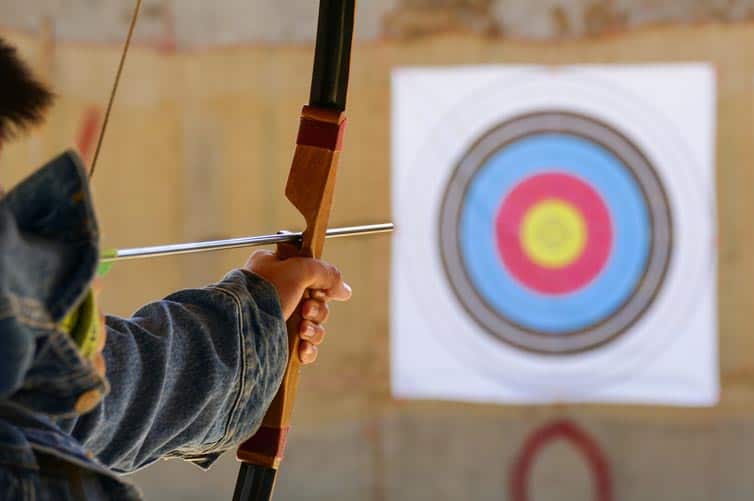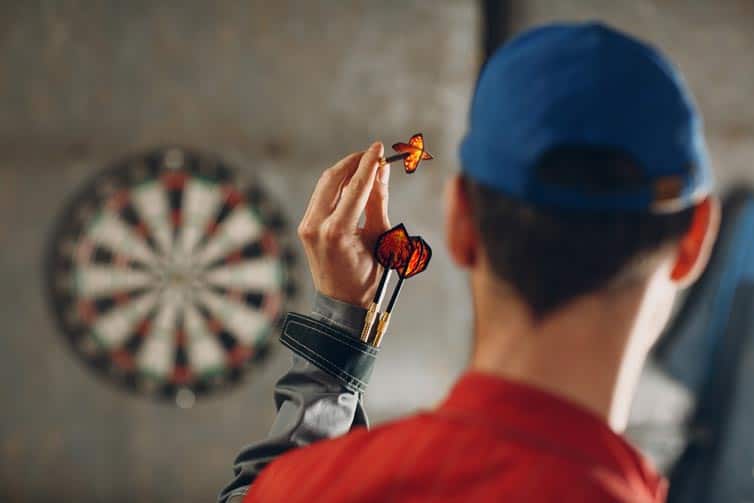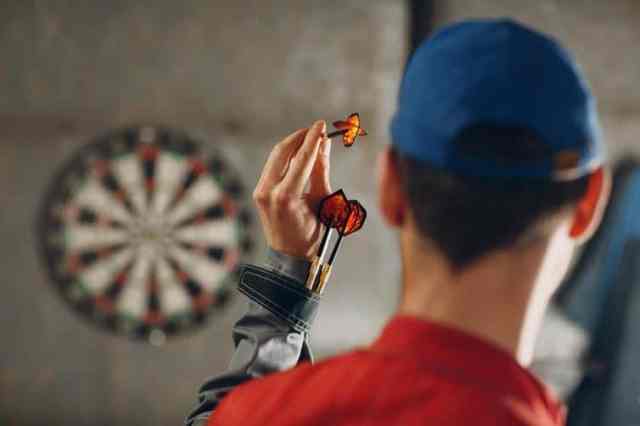Everyone knows about “normal” garage hobbies like working on cars and woodworking. But what are the most dangerous hobbies that people do in a garage?
Disclaimer: Alan’s Factory Outlet does not endorse or recommend any of these dangerous hobbies. This article is for educational purpose only.
Dangerous Garage Hobby 1: Archery

Archery is loved by people of all ages. The history of archery dates back to the earliest humans, who learned to use a bow and arrow to more efficiently hunt their food. Today, people still hunt with bows, but many other people interested in archery only shoot at nonliving targets. There are many different kinds of bows, meaning people of various shapes, sizes, and strengths can find a bow that fits them well.
Bows and Equipment
One of the nice things about archery is how accessible it is. Anyone who spends time practicing can develop impressive archery skills. Archers choose between recurve or compound bows. It depends on their shooting style as well as their budget and experience level. Recurve bows are cheaper, safer, and much easier to shoot. Compound bows offer more power and are usually used by bowhunters.
Archery Competitions
Tournaments are open to archers of all skill levels and ages. Local tournaments are a great place for beginners to get started in competitive archery. Typically, tournaments include target shooting, 3D archery, and field archery events. They can be held indoors or outdoors, depending on the types of targets being used. Archers shoot from specific distances from the target based on their skill level and age group. Field archery tournaments require participants to walk through a course and aim at each target along the way. Outdoor events may also be 3D tournaments, which involve life-size replicas of wild animals such as deer and moose.
Bowhunting
Many archers are also interested in hunting. Bowhunting requires participants to follow safety measures and be responsible. That starts with getting the right equipment. The bow must match the archer’s strength and draw length. The draw weight should increase along with the archer’s skill set and strength. Bowhunters will also need a quiver, arrows, and accessories such as sights and a wrist guard. Archers will want to spend lots of time in target practice before they hunt. Ethical hunting requires excellent technique because the goal is to take down the animal as quickly and humanely as possible. That requires sound technique.
Safety and Technique
Safety is a crucial part of archery. A lot of states consider bows and arrows firearms. It’s important that archers know and follow all of the local rules and laws regarding firearms and archery. Standard safety guidelines always apply. These include only loading an arrow when it’s safe to shoot and only ever aiming in safe directions. Always maintain control of the arrows. Archers should also always wear recommended safety gear, including arm guards.
Glossary of Archery Terms
- Aim: When an archer directs the bow toward the target
- Archer: The person who is shooting with the bow and arrow
- Arrow: A thin rod with a pointed end that is fired toward a target
- Bow: A cord connects two ends of this weapon, and the tension when the cord is released forces the arrow toward the target
- Bow Nock: A groove designed to hold the bowstring in place
- Bow Weight: The archer must use this much draw force to pull the bowstring back before releasing the arrow.
- Composite Bow: These bows are made of a variety of materials (including fiberglass or wood) that are laminated together
- Draw Length: The distance an archer pulls back the bowstring
- Dry Fire: When an archer practices the motion of pulling the bowstring back and releasing it without using an arrow (this should be avoided because it can damage the bow)
- Fletching: The official name of the feathers on the back of an arrow
- Grip: Where the archer’s hand rests in the center of the bow handle
- Limbs: Parts of the bow that extend out from the main structure
- Nock: Located behind the fletching, it’s where the arrow and bowstring connect
- Quiver: Archers keep their arrows here
- Recurve Bow: A bow that curves away from the archer at the ends
- Release: When the archer lets go of the bowstring and the arrow is propelled forward
- Riser: The riser separates the limbs of a bow
Dangerous Garage Hobby 2: Darts

Throwing games have existed for thousands of years, and they take a number of different forms. One of the most popular and enduring, the game of darts, has been around for centuries. In its current form, it’s both a popular pub game and an official competitive sport. Because the equipment needed is minimal (just a few darts and a board), it can be played almost anywhere. The game of darts is a mainstay at bars, in garages, and in dens all over the world. Besides the darts and board, all it takes to make an enjoyable afternoon is a few friends. The game can be as competitive or as laid-back as the group desires, and it can be played at any pace. Scoring can be adjusted to accommodate beginners, so it’s a perfect game to introduce to your friends. In addition to the fun factor, darts can have real health benefits. Playing darts gets the group up and moving around, and the need to focus on stability can help improve balance. The scoring and strategy aspects can help improve mental acuity as well. Overall, darts is a great game for your garage or game room.
History of Darts
There’s little definitive information about the origin of darts. The game is thought to be about 700 years old and is said to have first been played by soldiers. Between battles, soldiers had few ways to pass the time, so they likely invented games to relieve their boredom. Throwing knives or spearheads at a target was probably the first incarnation of the game of darts.
- Darts was well-established at multiple levels of society by the 1500s, with historical records indicating that Henry VIII received an ornate set of darts as a gift from Anne Boleyn in 1530.
- By the late 1800s, darts was a popular game throughout England. It was a popular pub game and a well-known leisure activity. It’s likely that American soldiers played darts when stationed in Europe during World War II and returned home with an appreciation for the game.
- Professional darts organizations began to appear in the 20th century, including the National Darts Association of Great Britain (NDAGB). The NDAGB was established in 1954 and set about popularizing the game and growing its television base.
- By the 1970s, the NDAGB’s prominent position was overtaken by the British Darts Organization (BDO). The BDO pursued sponsorship deals and catapulted darts to international awareness.
The Basics of Darts
The game of darts is simple overall, but there are a few specifics to keep in mind. While any darts-and-dartboard setup is fine for a friendly, casual game, official games must adhere to the established rules.
- The dartboard must be located a precise distance from the floor. Specifically, the center of the bullseye must measure 5 feet 8 inches (173 cm) from the floor.
- The distance between the dartboard and the players is also important. The oche, also called the toe line or throw line, is the line where players stand. It must be located 7 feet 9 ¼ inches (237 cm) from the front of the dartboard. To keep the playing field even, players are not permitted to step beyond this line while throwing.
- Scoring isn’t as straightforward as just trying to hit the bullseye. Instead, each section of the dartboard has a different scoring value. The wedge-shaped sections are worth the listed number of points. Striking the thin outer ring is worth twice that many points, while getting your dart into the thin inner ring scores triple. The bullseye is worth 50 points, and the concentric ring around the bullseye is worth half that, 25 points.
- Each player starts with a set number of points, and every score deducts from that total. The winner is the first player to reach zero points. In professional leagues, players start with 501 points, but amateur games can start with a lower number, such as 201.
- Some leagues or optional rules dictate how games start. An option called “doubling in” requires players to hit a double score area before any scoring is recorded. Points scored prior to the double are not counted.
- There are similar rules around how games end. Most dart games require an exact score to end the game. Games can also require “doubling out,” or scoring in the double area to end a game. In other games, a player may be required to hit the winning score with their final throwing dart.
How to Throw Darts
Throwing darts is easy, but throwing darts with precision takes practice. Because everyone’s bodies are different, finding the proper grip, stance, and throwing mechanism can be different for everyone.
- Many players use a “pencil grip,” holding the dart between their index finger and thumb, with the middle finger providing support. Some prefer to use only the index finger and thumb. There’s no right or wrong way; it just depends on what feels comfortable to you.
- Hold darts firmly but not too tightly. A tight grip can reduce the dart’s balance. Keep the dart parallel to the ground, not tilted too high or low.
- The stance is important but is also subject to personal preference. Most players put one foot forward (the foot on the same side as the throwing hand). Putting the dominant foot forward and transferring weight to it helps maintain your balance.
- Players should keep lower body movement to a minimum, focusing on throwing the dart with their hand, wrist, and arm. Keeping the lower body from moving will improve the dart’s stability.
- When starting out, many players throw darts too hard. Because the board is less than eight feet away, players don’t need to use a lot of power. It’s more important to control the dart’s flight and get it where you want it.
- The ideal throw involves the wrist and forearm snapping forward quickly, while the rest of the body remains mostly still. This takes extensive practice, both to find the best throwing motion for you and to train your muscles for consistency.
Tips for Beginners
Like golf or billiards, darts is an easy game to start playing, but a difficult one to master. Because it may look easy, it’s not uncommon for new players to become discouraged if they don’t succeed at the game right away. Fortunately, by sticking with your practice routine, you’ll see improvement in a very short time.
Everyone has bad throws now and then. Being consistent in your mindset, approach, and throwing motion will help you to recover from bad throws.
While many of us don’t find math to be fun, learning the intricacies of darts scoring can really help your game. The math is simple, but it can be important. When you can size up a board and know just where you need to put your darts to win in the fewest throws, your confidence will grow.
Knowing the rules is just as important as understanding scoring. If you play a great game only to find out that your last throw didn’t win because it wasn’t a double, you could get discouraged. Knowing the rules used by your league or pub group is a big advantage.
Other Dangerous Garage Hobbies
- Dangerous pets have been known to bite their owners.
- You might strain a muscle trying to make a difficult shot playing table tennis or air hockey.
- Boxing and wrestling are dangerous anywhere, and have caused many deaths and permanent injuries
- You could fall while practicing gymnastics.
- Fencing isn’t always dangerous, but can be if you aren’t wearing the appropriate protective gear.
- Martial arts were designed to be dangerous.
- You can lose a lot of money playing poker, and some people become addicted to the game, causing great harm to their families.
- Weightlifting can cause permanent injuries if not done properly.
The Most Dangerous Garage Hobby Ever
DIY projects are the most dangerous hobby commonly done in a garage. DIY projects have caused countless injuries, but they are rarely reported as a “do-it-yourself injury,” so we will never know just how dangerous this hobby is.
Don’t underestimate the risks of using power tools in a dim environment. Many men (and some women too) have lost fingers, shocked themselves, and have sustained various other injuries upon themselves while working on a DIY project in their garage.
As always, use wisdom and caution before starting a potentially dangerous hobby in your garage. There are also other safer hobbies like painting, reading, or photography which some may like?



